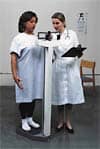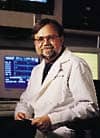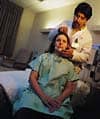Service With A Smile
Vanderbilt Sleep Disorders Center provides luxurious sleep by testing patients at its new facility in the Marriott Hotel.
 From left, Paul Schmitz, associate director of neuroscience, Beth A. Malow, MD, MS, medical director and neurologist, Chris Ziegler, RPSGT, technical supervisor, and James Sheller, MD, pulmonologist.
From left, Paul Schmitz, associate director of neuroscience, Beth A. Malow, MD, MS, medical director and neurologist, Chris Ziegler, RPSGT, technical supervisor, and James Sheller, MD, pulmonologist.
Up against a dearth of available space on campus, Nashville’s Vanderbilt University decided to look off-grounds for a suitable site to expand its increasingly in-demand sleep center; however, rather than lease rooms from an austere medical office building where simulating conditions conducive to somnolence might prove expensively daunting, the center instead took up residence at a nearby luxury hotel—a setting tailor-made for comfortable sleep.
“Patients who have undergone studies in our hotel-based center have commented favorably on the surroundings,” says Beth A. Malow, MD, MS, medical director of the Vanderbilt Sleep Disorders Center, ABSM Diplomate, and an associate professor of neurology at the school. “They tell us that their sleep is more typical by being in this particular environment.”
University officials too have commented favorably on the arrangement, especially because it made a great deal of economic sense.
“We wanted to lease space that didn’t have to be built out, that wouldn’t involve tearing out walls, and then going to the expense of decorating and furnishing,” Malow says. “We wanted something we could utilize as is in order to minimize our costs. The only kind of space that met these criteria was a hotel.
“Pretty much all we had to do was bring in our monitoring equipment and wire the sleep rooms to the control room. Everything else was provided.”
Team Approach
Opened for business in August 2003, the recently AASM-accredited, 4,000-square-foot Vanderbilt Sleep Disorders Center occupies 11 of the approximately 40 rooms on the fifth floor of the Marriott Vanderbilt Hotel, adjacent to campus. Six of the center’s rooms are devoted to overnight studies. The seventh serves as the control room; the remainder are utilized for reception, consultations, support, and other purposes, says Sandy McMasters, RPSGT, RRT, center manager.
In setting up shop at the Marriott, Vanderbilt purchased eight complete sleep-study systems along with a new server to house the data generated by those testing units (the original, on-campus center with two beds remains in place for testing requiring special support services). Studies are conducted 7 nights each week at the hotel; plans are afoot to add four additional sleep rooms. The center offers standard polysomnograms, polysomnograms with extended EEG and video monitoring for seizures and parasomnias, additional limb monitoring for REM sleep behavior disorders, and multiple sleep latency tests.
 Technologist Pennington Grubb, prepares a patient for testing.
Technologist Pennington Grubb, prepares a patient for testing.
Employing a multidisciplinary team approach, the Vanderbilt unit brings to the fore specialists from neurology and pulmonary, as well as those from psychiatry, pediatrics, otolaryngology, and maxillofacial surgery (also aboard is a CPAP specialist who coordinates with home health care providers).
“One of the strengths of our center is the ability to evaluate patients with neurological, medical, or psychiatric conditions that may involve sleep disorders, such as epilepsy, Parkinson’s disease, stroke, depression, or heart and lung disease,” Malow says.
 A young patient is evaluated for possible sleep apnea.
A young patient is evaluated for possible sleep apnea.
About half the center’s patients live in and around Nashville. The balance come from distant parts of Tennessee and from other states in proximity, chiefly Kentucky, Georgia, and Alabama. Approximately 20% of all patients are children. Roughly 20% of the sleep studies are reimbursed with state and federal dollars, while 70% are paid through managed care arrangements; a mere 10% fall under the heading of fee-for-service, Malow indicates.
Boon To Business
Although there are at least 10 other sleep laboratories in the Nashville area, none apart from Vanderbilt’s is hotel-based. “We looked at other kinds of properties, but the idea of using a hotel held for us the greatest appeal,” McMasters says.
Three hotels were considered as candidates. All were reasonably near to Vanderbilt University, and each offered ample convenient parking, she says. Eventually, Marriott emerged as the winning choice.
Says Malow, “It was the most luxurious. It also was the best soundproofed so we wouldn’t have to worry about our patients being disturbed by noise from guests down the hall or on other floors.”
For their part, Marriott executives expressed no qualms about installing a sleep center in the midst of a resort catering almost exclusively to vacationers and business travelers. “Marriott recognized that the sleep center would not be an intrusive addition,” McMasters says.
Indeed, the hotel concluded that the presence of a sleep center would be a welcome boon to business, first, by guaranteeing tenancy for an entire quarter of a floor of rooms the year around, and second, by providing an avenue to acquaint more people with the hotel in general so as to encourage their patronage as guests of the more conventional sort.
This is not to suggest, however, that the formation of a relationship between the center and the hotel was by any means a slam-dunk process. “The contract negotiations involved constant back-and-forth over a lot of fine details,” Malow reveals.
One point of contention: signage. “The hotel was a little hesitant to display our full and proper name, the Vanderbilt Sleep Disorders Center,” Malow says. “They worried that the word disorders on our signage might unsettle some guests.”
One of the requirements for AASM accreditation is clear signage, and the hotel did agree to the use of Vanderbilt Sleep Disorders Center on the door.
The signage has been a trifling matter, completely inconsequential when compared to the advantages of hotel-basing. Among the most prominent of those is the ability to readily expand as warranted by burgeoning requests for services. “Our expansion possibilities are dramatic,” Malow says. “All we have to do is give the hotel sufficient advance notice, and they can assign us the additional rooms necessary to meet our growth needs.”
Conceivably, the center could take over the entire fifth floor. Not likely any time soon, Malow assures, although the 10-bed configuration has been approved.
 Neurologists Beth A. Malow, MD, MS, and Muhammad Al-Kaylani, MD, confer with lead technologist Deby Bean, RPSGT, (seated) about a patient’s sleep record.
Neurologists Beth A. Malow, MD, MS, and Muhammad Al-Kaylani, MD, confer with lead technologist Deby Bean, RPSGT, (seated) about a patient’s sleep record.
Pulmonologist James Sheller, MD, one of the ABSM Diplomates in the sleep center, believes expansion—while easily achievable in this setting—will pose a new set of demands all its own. “The biggest challenge will be expansion of the center’s throughput without compromising the outstanding services offered,” he says. “This involves clinic issues, such as scheduling and visits. Most important, it involves finding and, if necessary, training technicians to perform the high-quality studies we have come to expect.
“In anticipating having to meet this challenge, we’re offering what we believe is an excellent work environment, with many opportunities to learn and participate in the center. Additionally, we’re offering on-the-job training for skilled and motivated individuals interested in sleep.”
It Connection
An earlier challenge with which the center dealt centered around access to Vanderbilt University’s paperless system of charting.
“We needed to be able to log onto the Vanderbilt network from our computers in the sleep center and have instant access to the electronic patient records—clinic notes, laboratory results, appointments, the works,” Malow says. “Without the electronic patient record system, we’d be forced to send hard-copy charts back and forth between the hotel and our clinics on campus. Such a situation would have been a disaster for us.”
And therein lies yet one more reason for choosing to site at the Marriott. Neighboring the hotel was an office building with an already existing fiber-optic telecommunications infrastructure linked directly to the voice and data networks back at Vanderbilt University.
“This offered the possibility of relatively easily tying into the network, with significant cost savings the result,” Malow says.
To make the connection, the center pulled single-mode, one-gigabit fiber-optic cable to the Marriott from that nearby building, says Paul Schmitz, associate director for neuroscience at Vanderbilt University Medical Center.
“This one-gigabit size of connectivity provides the bandwidth necessary to let us transmit as many as six studies simultaneously to the server at the Vanderbilt campus and back again,” he explains, adding that Marriott gave the center permission to use one of the hotel’s existing network closets for placement of Vanderbilt telecom devices and switches. “Further, firewalls are installed at both ends of the connection to ensure the security of data, which, by the way, are encrypted. And uninterruptible power supply boxes are deployed in every room to keep a safe flow of electricity going to the computers and monitors during brownouts or surges that might affect the hotel.”
Malow cites Schmitz’s placement on the team as a key to the center’s success. “It was decided at a very early juncture to appoint someone from the information technology (IT) department to an associate directorship in our center,” she says. “Having an IT person in that role has been invaluable not only in helping us remotely access the Vanderbilt electronic patient record system, but also in smoothing the way to acquire the right equipment at the best prices.”
Love To Live There
The center is a great place to visit, but clearly quite a few of the sleep technologists would not mind living there. Can they be faulted for that? After all, their plush control room enjoys a sweeping view of colorful Centennial Park, a greenbelt brimming with old Nashville charm. They never have to make up the beds after the patients depart for home. That is handled for them by the hotel’s maid service.
It is not, however, just the technologists who enjoy the amenities. Patients, too, think the Vanderbilt Sleep Disorders Center at the Marriott Vanderbilt Hotel is a terrific place to be. That is why, Malow reports, more and more of them are choosing to undergo study there as opposed to someplace else.
“This was,” she says, “as smart a move as any we could have made.”
| Patient Satisfaction The Vanderbilt Sleep Disorders Center credits at least part of its success to minimization of the need to repeat tests. The secret? The center simply makes a point of seeing each patient for an evaluation prior to the day on which a study is scheduled. “In doing this, we can be sure we’re ordering the correct tests and slotting them in the right order,” says Beth A. Malow, MD, MS, medical director. “As a bonus, we can use this encounter as an occasion to provide education that lets the patient know beforehand what’s in store, which means satisfaction will be higher.” Patient satisfaction is further reinforced by the way sleep studies draw to a close. “We don’t just send patients home the next morning,” Malow says. “Before they depart, they’re seen by a nurse practitioner and their studies will have been reviewed by our sleep fellows. When they do go home, they go home with a plan in hand. “The plan might be anything from a CPAP trial to a clinic follow-up. But the point is, a plan is in place,” and the patient understands where things go from there. Many of the cases seen by the center team are about as challenging as they come. Take, for instance, the one involving an ostensibly healthy 2-year-old boy brought in for testing to find out why he every now and again stopped breathing for no apparent reason. Suspecting seizures as the cause, Malow ordered an extended 21-channel EEG in addition to the standard monitoring for sleep apnea. That same night, while the child was in the sleep center, he again stopped breathing. Analysis of the captured event revealed telltale electrical activity in the brain in the moments leading up to the commencement of apnea, further supporting the notion that seizure might be the cause. The boy subsequently underwent monitoring in Vanderbilt’s epilepsy unit where he was confirmed to be a victim of seizures. Treatment with appropriate medications has been effective in allowing the youngster to live normally—and in permitting his parents to put him to bed free of the gnawing fear of losing him during the night. |
Rich Smith is a contributing writer for Sleep Review.



